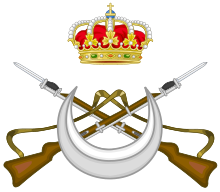Regulares
The Regulares ( Fuerzas Regulares Indígenas , in German: Regular Indigenous Forces ) are a large elite group of the Spanish army . Today they are mainly stationed in the Plazas de soberanía along the Moroccan coast, but also occasionally take part in international peace missions. Originally, the Regulares were recruited from the native population of Spanish Morocco , now mostly from the inhabitants of Ceuta and Melilla .
history
The Regulares were founded in 1911 under General Dámaso Berenguer Fusté with the aim of creating a light infantry with a good knowledge of terrain and combat tactics of the enemy in the course of the Rif Wars. For this purpose, mostly locals from Spanish Morocco were recruited. In addition to their work in the Rif Wars, the Regulares also took part in the suppression of the miners' uprisings in 1934 during the Second Spanish Republic . In the course of the Spanish Civil War , the Regulares fought at the forefront on the side of the insurgents under Francisco Franco , who in turn served with them between 1913 and 1920. After Morocco gained independence in 1956, large parts of the large unit, which at times comprised up to eight regiments ( grupos ), were dissolved. Today there are still two regiments. The Regulares are the most awarded existing unit in the Spanish Army.
assignment
The Regulares are a unit of the light infantry. Due to the fact that today they mainly serve to maintain Spanish sovereignty over the so-called Plazas de soberanía along the Moroccan coast, they specialize in house- to- house and combat in rough terrain.
organization
The regulares are traditionally and to this day divided into grupos (regiments) and tabores ( battalions ):
-
Grupo de Regulares de Melilla nº 52 (based in Melilla , Peñón de Vélez de la Gomera , Peñón de Alhucemas and Islas Chafarinas )
- Tabor Alhucemas I
- Tabor Rif II
-
Grupo de Regulares de Ceuta nº 54 (based in Ceuta )
-
Tabor motorizado Tetuan II
- Anti-tank company
-
Tabor motorizado Tetuan II
uniform
The regulares wear khaki- colored uniforms, a white cape (called Alquicel ), a red sash and a red fez headgear. Due to the oriental-looking clothing and, as a desert regiment, their characteristic slow marching pace of 60 paces per minute with their regimental music, they are a very popular guest at military parades .
literature
- María Rosa de Madariaga: Los moros que trajo Franco. La intervención de tropas coloniales en la guerra civil española , Barcelona (Ed. Martínez Roca) 2002. ISBN 84-270-2792-3
Web links
- Official website of the Grupo de Regulares de Melilla nº 52
- Official website Grupo de Regulares de Ceuta nº 54

